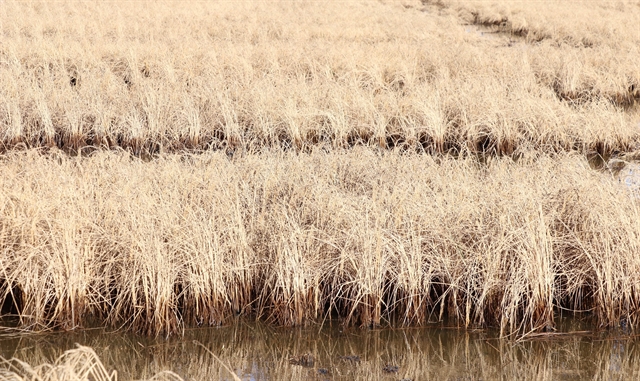 Society
Society

Many crop growing areas in Cà Mau Province’s freshwater zones are facing a severe shortage of water because of a prolonged dry spell.

|
| Extended dry weather has damaged the rice crop in many areas in Cà Mau Province. – VNA/VNS Photo Thế Anh |
CÀ MAU – Many crop growing areas in Cà Mau Province’s freshwater zones are facing a severe shortage of water because of a prolonged dry spell.
Cà Mau is the only province in the Cửu Long (Mekong) Delta that cannot access water from the Mekong and relies mostly on rainwater for irrigation.
Lý Văn Lâm Commune, one of the largest vegetable growing areas in Cà Mau City, has seen its irrigation canals dry up and farmers struggle to find water for their crops.
Following instructions from local authorities at the beginning of the ongoing dry season, farmers grew only short - term crops like onion, bitter melon, mustard greens, gourds, and cucumber.
To secure water for their vegetables, many farmers have had to drill borewells to draw groundwater. But groundwater has become scarce and farmers drilling now have difficulty finding water.
Mạc Ngọc Truyền, chairman of the Lý Văn Lâm Commune Farmers Association, said the association has told farmers not to grow vegetables on large areas like they did before.
This would help farmers save water, use water meant for domestic use and mitigate the losses caused by the drought, he said.
In Trần Văn Thời District, vegetable farmers are facing a poor harvest because of the lack of water while the prices of vegetables have fallen dramatically.
Vũ Đăng Khoa, chairman of the Minh Hà Agriculture Service Co-operative in the district’s Khánh Bình Đông Commune, said after Tết (Lunar New Year) members grew pumpkin and gourds.
When the crops began to bear fruit, there was no water and the yield is set to fall by half, he said.
The co-operative’s members have built a temporary dam to store water, but there is not enough to irrigate crops, he said.
Fruit growing areas in the province have been affected by a lack of water and farmers have had to make great efforts to save their fruit trees.
Nguyễn Văn Thịnh, who has a 1ha guava orchard in Trần Văn Thời District’s Khánh Hưng Commune, said the leaves of many trees have withered.
He had to prune many branches to save the trees, but many still died, he said.
“The source of irrigation water for the orchard is a river. This year the drought has been severe and the river has dried up.”
The dry weather has been forecast to continue, and agricultural officials have instructed fruit farmers to take measures to save their trees.
Farmers are instructed to use rice straw, dried grass and dried leaves to cover the roots to lock in moisture, and prune branches to reduce the quantity of water required by the trees.
Drought and saltwater intrusion had wholly or partially affected more than 20,500ha of crops including rice in the province as of early April, according to the province’s Department of Agriculture and Rural Development.
Sowing schedules
To mitigate losses to the summer – autumn rice crop caused by dry weather, the department has established farming schedules for various localities.
The province plans to grow a total of 36,000ha of summer – autumn rice in Trần Văn Thời, U Minh and Thới Bình districts and Cà Mau City.
The schedules require farmers to sow 27,000ha of rice after they finish preparing the land. The remaining 9,000ha will be sown when there are rains. The rainy season normally begins in May.
High-quality varieties will account for 65 – 70 per cent of the province’s summer – autumn rice area, fragrant and specialty varieties for 10 -15 per cent and medium-quality varieties for 10 per cent.
The department has urged farmers to grow more high-quality and fragrant varieties since they are in high demand.
Nguyễn Trần Thức, head of the province Plant Cultivation and Protection Sub-department, said rice farmers should adopt advanced farming techniques to improve quality, reduce costs and improve their incomes. – VNS




